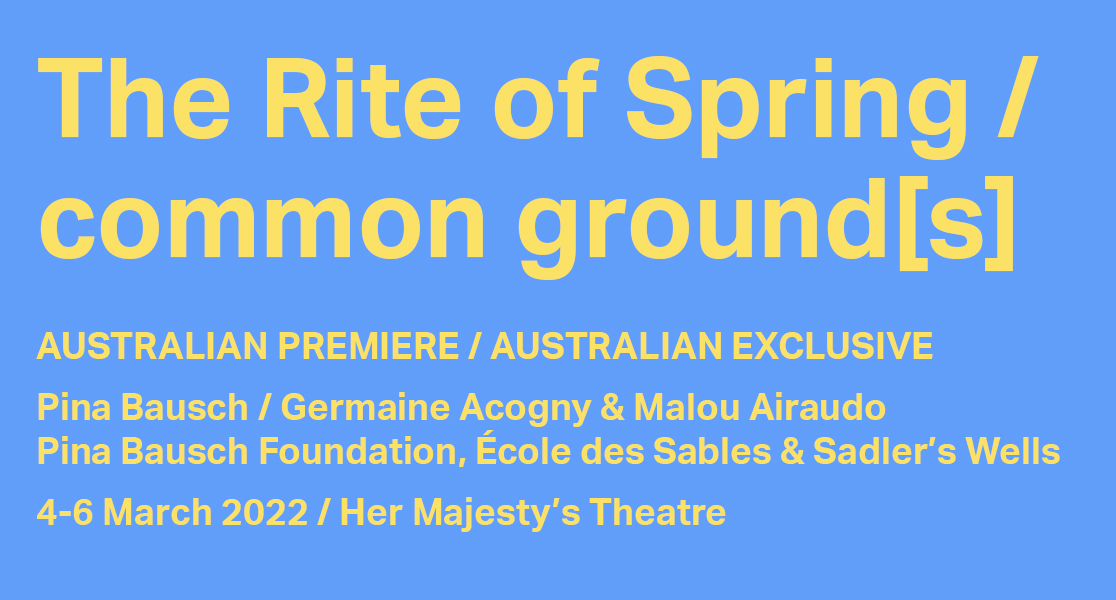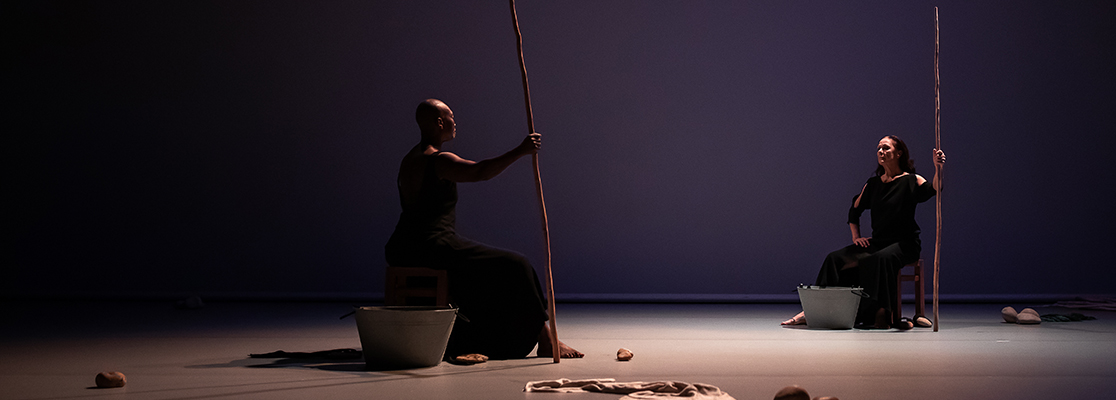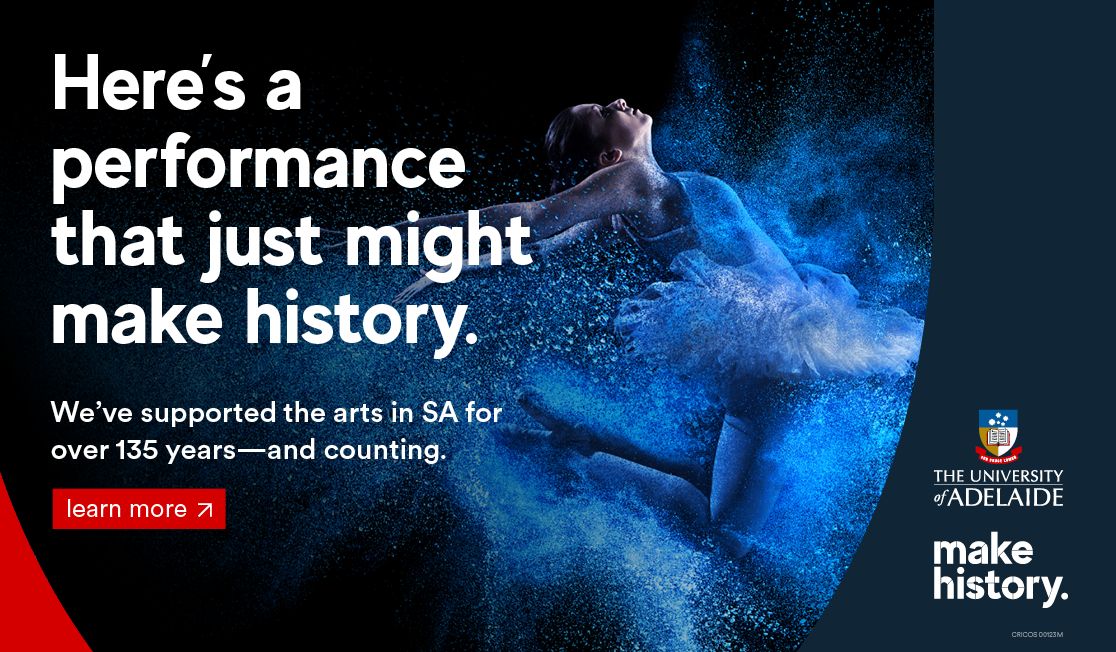Your Daybill
Info
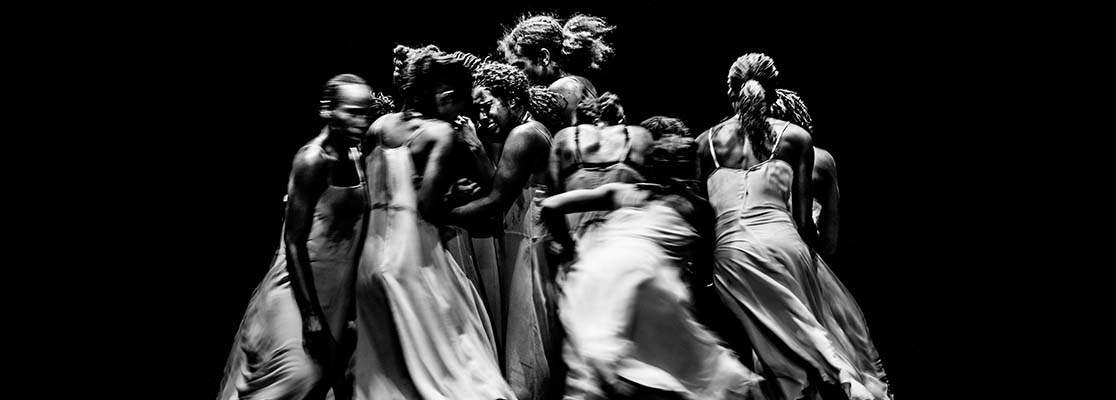
Credits
A Pina Bausch Foundation, École des Sables and Sadler’s Wells production
common ground[s]
By Germaine Acogny & Malou Airaudo
and
The Rite of Spring
By Pina Bausch
A Pina Bausch Foundation, École des Sables & Sadler’s Wells production, co-produced with Adelaide Festival, Théâtre de la Ville, Paris; Les Théâtres de la Ville de Luxembourg; Holland Festival, Amsterdam; Festspielhaus, St Pölten; Ludwigsburg Festival; Teatros del Canal de la Comunidad de Madrid and Spoleto Festival dei 2Mondi.
The project is funded by the German Federal Cultural Foundation, the Ministry of Culture and Science of the German State of North Rhine-Westphalia, and the International Coproduction Fund of the Goethe-Institut, and kindly supported by the Tanztheater Wuppertal Pina Bausch.
Creative Team
for common ground[s]
Co-Choreographers and Dancers Germaine Acogny, Malou Airaudo
Composer Fabrice Bouillon LaForest
Costume Designer Petra Leidner
Lighting Designer Zeynep Kepekli
Dramaturg Sophiatou Kossoko
Musicians (recording)
Bass Adam Davis, Carlota Margarida Ramos
Cello Ana Catarina Pimentel Rodrigues, Mariana Silva Taipa
Viola Wei-Chueh Chen, Alejandro Vega Sierra
Violin Nicolas Lopez, Ana Maria Sandu, Alexandru-Adrian Semeniuc
Keyboard Fabrice Bouillon LaForest
Conductor Prof. Werner Dickel
Sound Engineer Christophe Sapp
Live Mix Tristan Assant, Fabrice Bouillon LaForest
for The Rite of Spring
Choreography Pina Bausch
Music Igor Stravinsky*
Set and Costumes Rolf Borzik
Collaboration Hans Pop
World Premiere 3 December 1975, Opera House Wuppertal
*Le sacre du printemps (1947 version) Cleveland Symphony Orchestra conducted by Pierre Boulez. Courtesy of Sony Music Entertainment by arrangement with Sony Music Entertainment Australia Pty Ltd.
Restaging
Artistic Directors Josephine Ann Endicott, Jorge Puerta Armenta, Clémentine Deluy
Rehearsal Directors Ditta Miranda Jasjfi and Çağdaş Ermiş, Barbara Kaufmann, Julie Shanahan, Kenji Takagi
Dancers Rodolphe Allui, Sahadatou Ami Touré, Anique Ayiboe, Korotimi Barro, D'Aquin Evrard Élisée Bekoin, Khadija Cisse, Sonia Zandile Constable, Rokhaya Coulibaly, Inas Dasylva, Astou Diop, Serge Arthur Dodo, Franne Christie Dossou, Estelle Foli, Aoufice Junior Gouri, Luciény Kaabral, Zadi Landry Kipre, Bazoumana Kouyaté, Profit Lucky, Vuyo Mahashe, Babacar Mané, Vasco Pedro Mirine, Stéphanie Mwamba, Shelly Ohene-Nyako, Brian Otieno Oloo, Harivola Rakotondrasoa, Oliva Randrianasolo (Nanie), Asanda Ruda, Amy Collé Seck, Pacôme Landry Seka, Gueassa Eva Sibi, Carmelita Siwa, Amadou Lamine Sow, Didja Kady Tiemanta, Aziz Zoundi
With thanks to Gloria Ugwarelojo Biachi, Florent Nikiéma, Tom Jules Sammie, Armel Gnago Sosso-Ny
Technical Team
Head of Production Adam Carrée
Company Stage Manager Marius Arnold-Clarke
Company Manager Laye Kane
Head of Stage Ben O’Grady
Sound Engineer Dan Harmer
Wardrobe Manager Anne-Marie Bigby
Production Electrician Joe Pilling
Costume Maker Petra Leidner
Costume Assistants Mariola Kopczynski (Dakar), Silvia Franco (Wuppertal)
Lighting Programmer Imogen Clarke
Producers
For Pina Bausch Foundation
Executive Director Salomon Bausch
Managing Director Simone Rust
Project Manager Gertraud Johne
Communications Denise Fertig
Education and Outreach Kathrin Peters
Assistant to the Directors Nicole Pieper
For École des Sables
Founders Germaine Acogny and Helmut Vogt
Manager Helmut Vogt
Technical Production Manager Didier Delgado
Production Stan Mandef, Mame Bousso MBaye
Coordinator Paul Sagne
Casting/adviser Patrick Acogny
Accounting Phillipe Bocandé
Communications Eleine de Graça-Sccientia
For Sadler’s Wells
Artistic Director & Chief Executive Sir Alistair Spalding CBE
Executive Producer Suzanne Walker
Head of Producing & Touring Bia Oliveira
Senior Producer Ghislaine Granger
Assistant Producers Hannah Gibbs, Gráinne Pollak
Tour Producer Aristea Charalampidou
Marketing Manager Jordan Archer
Press Officer Laura Neil
Marketing Assistant Chantal Edwards
Services
Production Management (in Senegal) Gacirah Diagne, Association Kaay Fecc (Papa Abdoulaye Faye, Mamadou Coumba Diouf, Francis S. Gomis, Jean Louis Junior Gomis, Ouleymatou Niang)
Technical Production Management (in Senegal) Abdou Diouf (for Les Ateliers Abdou Diouf)
Audition Partners (in the Ivory Coast, Burkina Faso and Senegal) Ange Aoussou (for Compagnie Ange Aoussou), Salamatou Diene (for CDC – La Termitière) and Gacirah Diagne (for Association Kaay Fecc)
Filming Fontäne Film: Florian Heinzen-Ziob (Director & Editor), Enno Endlicher (Cinematographer), Armin Badde (Sound Engineer) et Igor Novic (Additional Camera Operator)
Photography Maarten Vanden Abeele
With thanks to
Petra Boettcher, Keyssi Bousso, Stefan Brinkmann, Ismaël Dia, S. E. M. Abdoulaye Diop, Theowen Gilmour, Dr. Massamba Guèye, Dirk Hesse, Hochschule für Musik und Tanz Köln (Wuppertal), Lani Huens, Anne Teresa de Keersmaeker, Daniel King, Nassy Konan, Abdoulaye Koundoul, Folkwang Universität der Künste, Claudia Lüttringhaus, Pascal Moulard, Abdoul Mujyambere, Balla Ndiaye, Birane Niang, Madeline Ritter, Chelsea Robinson, Sahite Sarr Samb, Mohamed Y. Shika, Gabriel Smeets, Felicitas Willems, Laura-Inès Wilson, Wuppertaler Bühnen
Daybill Photographs
The Rite of Spring Maarten Vanden Abeele Ⓒ Pina Bausch Foundation
common ground[s] Roswitha Chesher
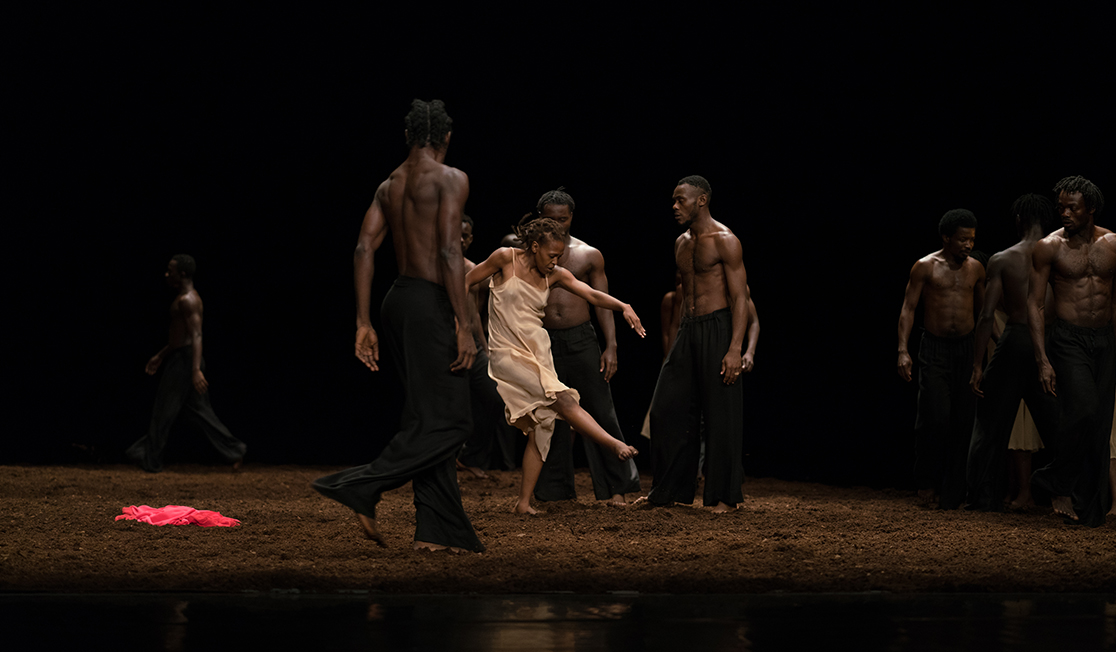
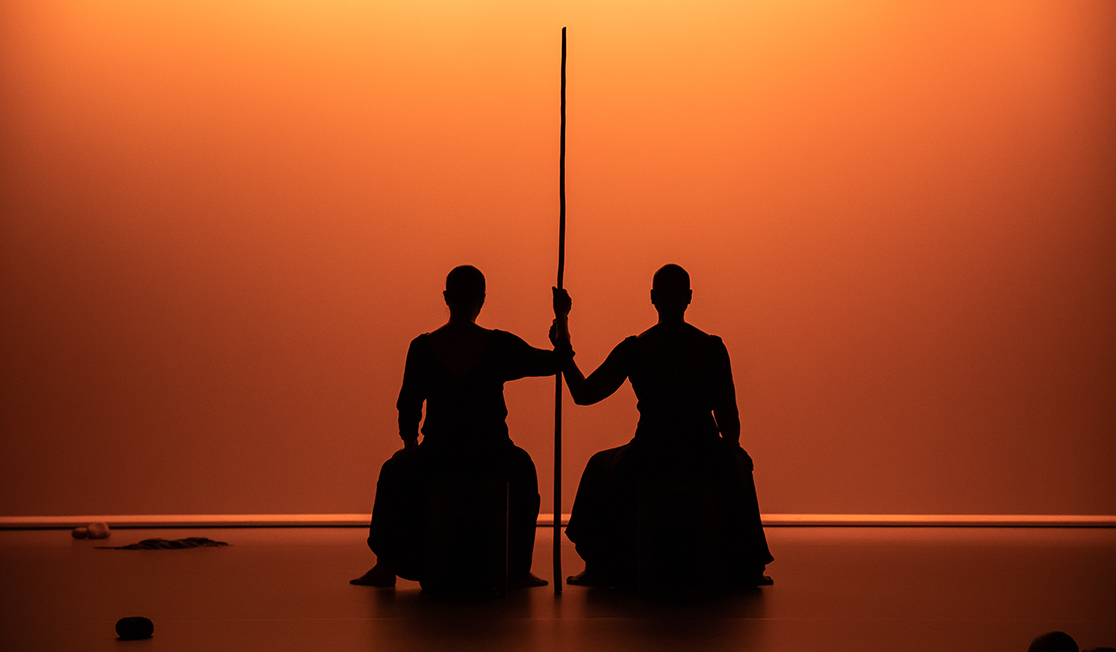
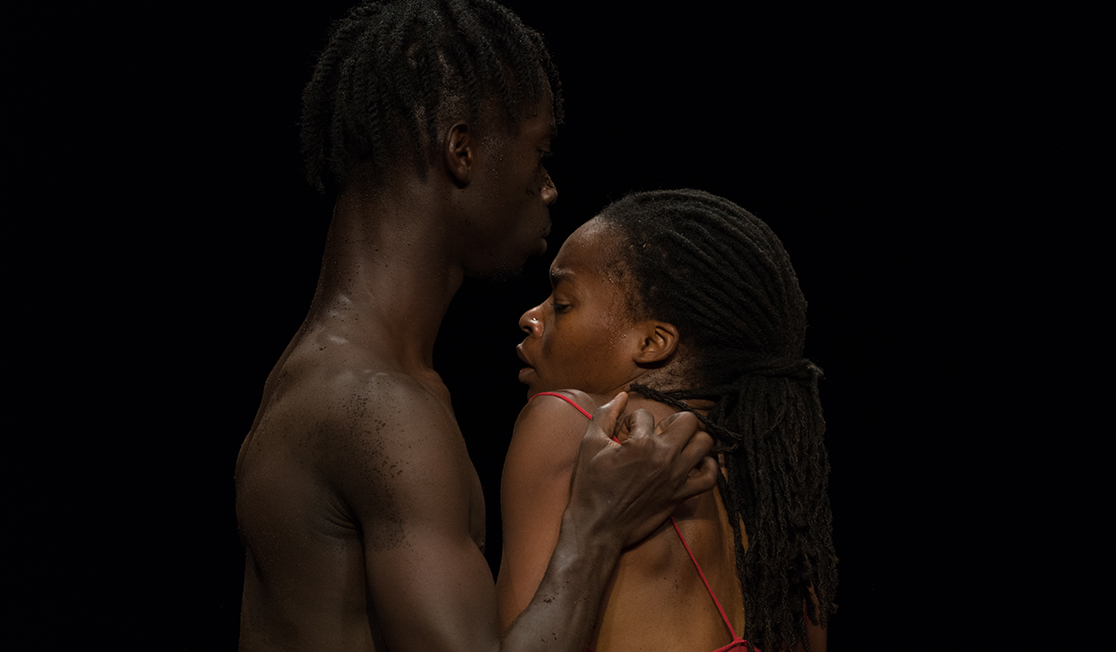
About the Project
By Sarah Crompton
It's been 11 years since the death of Pina Bausch, yet this programme is inspired by her pioneering spirit. It represents only the fourth time that any group of dancers outside her home company Tanztheater Wuppertal has danced her ground-breaking Le Sacre du Printemps, the first occasion it has been performed by a specially-recruited ensemble - and the first time it has been performed by dancers from African countries.
But for Germaine Acogny, co-founder of the influential École des Sables in Toubab Dialaw, Senegal, a centre for the teaching and development of traditional and contemporary African dance, this project also represents the culmination of her her long term admiration of Pina.
“I liked Pina and I liked her work,” she says, today. “There is a synergy between what we both were doing. For me, Sacre should be danced by dancers from African countries because it is something universal. When I first heard the Stravinsky music, I felt it was an African rite.”
The idea for this version of Sacre, however, came from the Pina Bausch Foundation which is committed to keeping Bausch’s work alive both by preserving an archive and by encouraging new companies to perform and explore the creations under the supervision of dancers who worked with the choreographer herself.
Salomon Bausch, Bausch’s son and chair of the Foundation, believes that these “transmission projects” will help increase understanding of one of the 20th century’s most significant and important bodies of work. “I am really curious to learn what is inside this heritage,” he says. “What is it? What does it mean to people today? We need these new projects where we try to provoke things and learn new things, to do things in ways we have not done before.”
This particular project was always ambitious, even before its planned premiere at the Théâtre National Daniel Sorano in Dakar was derailed by the coronavirus pandemic. A co-production between the Foundation, École des Sables, and Sadler’s Wells in London, it has recruited dancers from 14 African countries to perform the work.
More than 200 dancers submitted video audition tapes to Josephine Ann Endicott and Jorge Puerta Armenta, former dancers with Tanztheater Wuppertal who were in charge of this staging. Then 137 were invited to workshops in Burkina Faso, Senegal and the Ivory Coast where they were taught excerpts from the material and a final cast of 38 were chosen. Then the rehearsal process began in earnest.
The dancers represent a range of backgrounds and techniques, which has made the project thrilling. “It will be different,” says Acogny. “But that’s what makes it exciting. These dancers will do what all dancers do; they will interpret the movement of Pina Bausch. The dance is always the same, but depending on what area you live in, there are different energies. The Chinese will dance it differently from the French, the Germans from the African Americans.” For Endicott, there were challenges in staging the work. “The many different backgrounds created a big soup that we had to bring together,” she says. “But the dancers had such spirit. We were all together in Pina’s world somehow.”
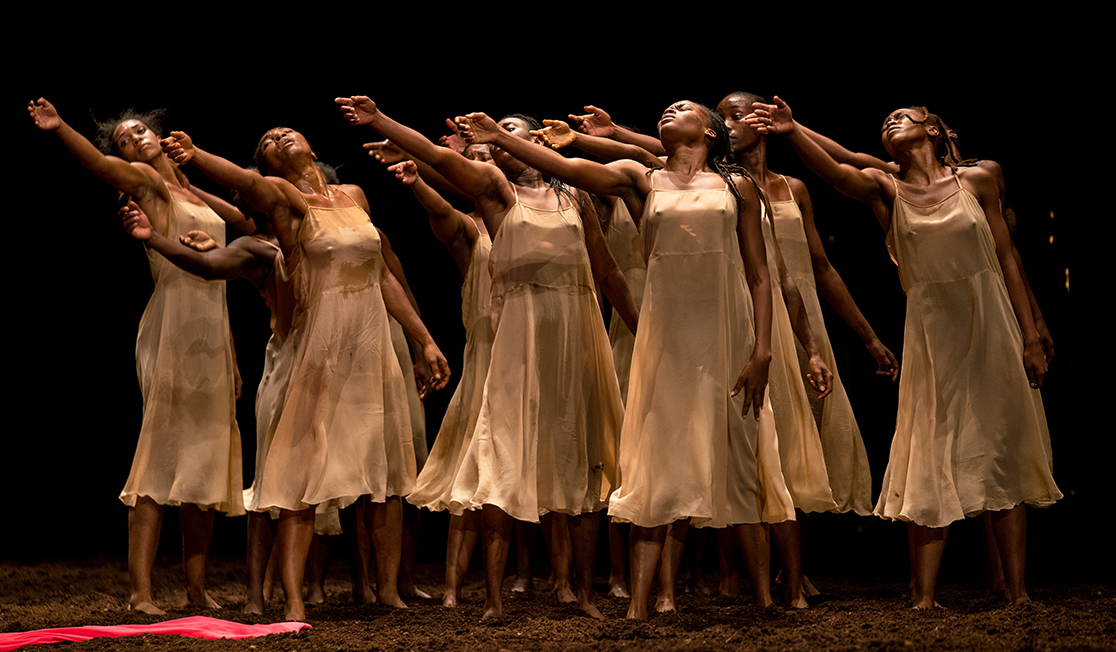
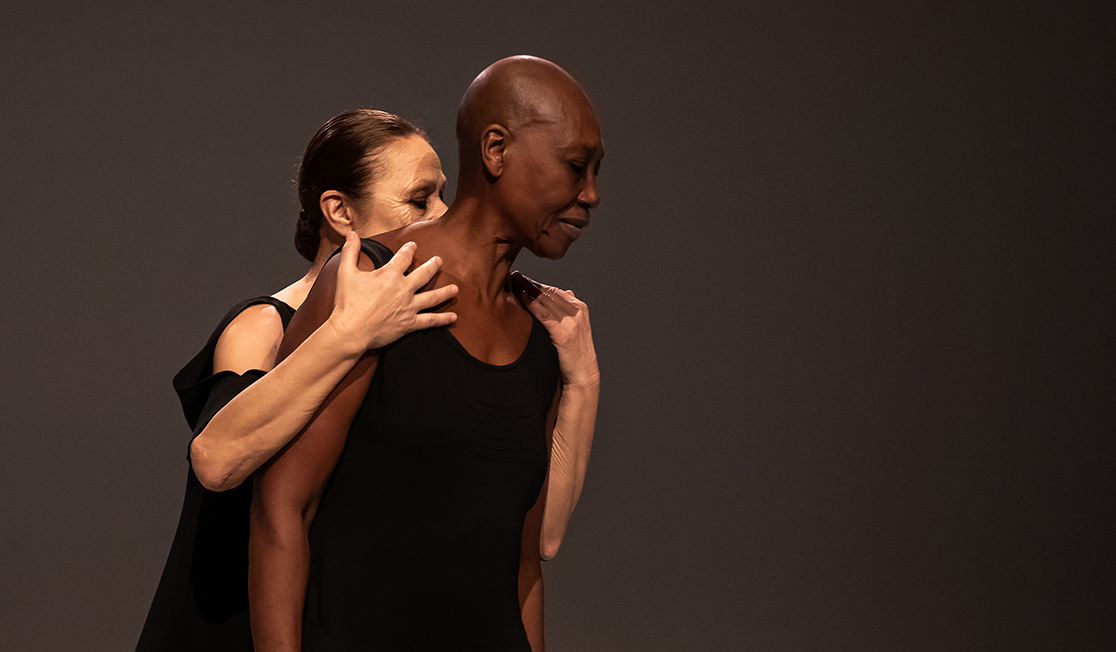
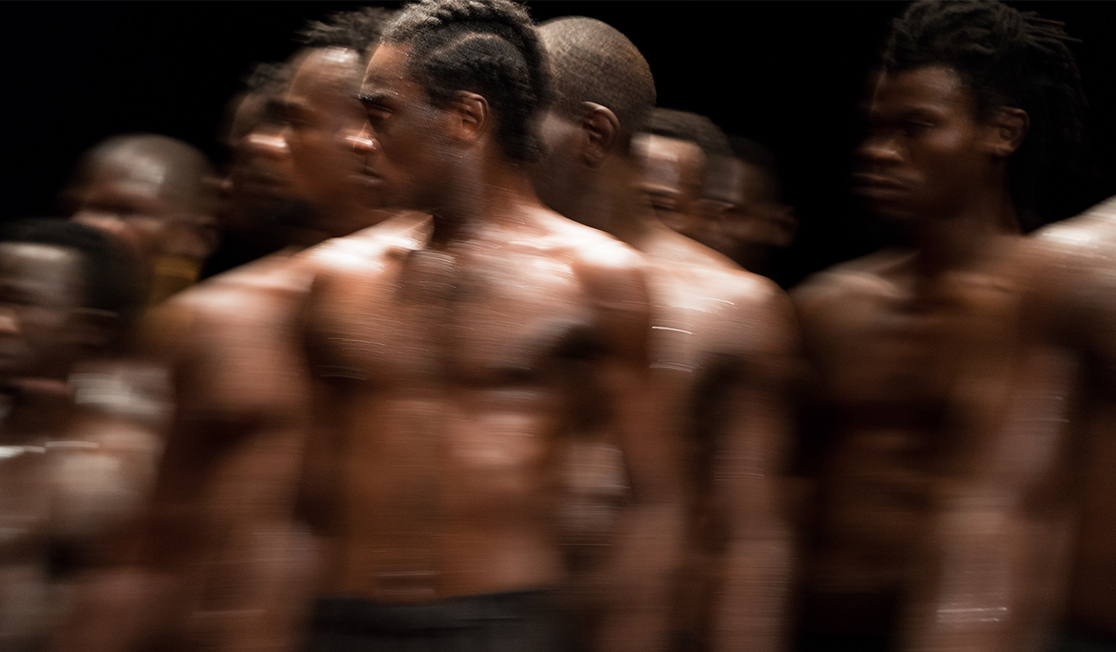
She noticed the way in which the dancers were particularly receptive to Stravinsky’s music - adapting to it more quickly and easily than some classically trained dancers do. In this, the collaboration reaches back to this version’s creation in 1975 when Bausch laid particular emphasis on the score. “She had this huge respect for the music,” remembers Endicott who was in the first cast. “It wasn’t easy finding the movements. We tried this and that until she was content. She always followed her instinct. The dance is the music, the dancers are the music. That’s the key.”
The piece also relies less on technique and more on a total immersion in Bausch’s visceral response to the score and the theme. “How would you dance if you knew you were going to die?” she asked, when trying to find the right steps to match the elemental power of the music. Her answer to that question means that Sacre, with its earthy stage of peat, requires extraordinary commitment and exposure from its dancers. Endicott observes: “You run with your heart and forget all you have learnt before and just come out and be yourself. It has to be real. If you are not exhausted at the end, you haven’t danced it properly.”
Acogny, now 77, remembers the impact the piece had on her when she first saw it performed in 1996, when Bausch restaged it for the Paris Opera Ballet. “In her work, Pina works with the human being, but she also works with the depths of humanity,” she says. But her own first encounter with the score was through the version created by the French choreographer Maurice Béjart, with whom she worked in Brussels and alongside whom she founded Mudra Afrique, the school from which she laid the basis for African contemporary dance. “It felt like a heathen rite and there were even elements of traditional African dance in his production.”
Later, at the age of 70, the woman who is known as the mother of African contemporary dance, performed the solo Mon Elue Noire, choreographed by Olivier Dubois, to the score. “Whenever I danced it, I invoked the name of Béjart, and I invoked Pina. Before I danced, I used to ask them to give me the energy to dominate the music. And I used to offer Stravinsky a cigar and a vodka as well,” she says.
Her close association with the piece means that it feels apt that the other work on this radical programme is on common ground[s] a duet this legendary dancer has created with the equally legendary Malou Airadou, one of the dancers who worked with Bausch from the beginning of her career. “I was very nervous to meet her because she was so close to Pina, but it has meshed together very easily,” Acogny says. “It has been very profound.”
The duet arose because Salomon Bausch wanted there to be something new in the programme. “It has been the meeting of two women to find out where they are in their lives, what they have been, what they have to say to each other,” Acogny says. Airadou, who is 71, agrees. “We don’t know each other but we find each other. We don’t have anything to prove. What we do is what we are. We were together, sharing together and what came out is what we felt.” She says creating the piece was quite straightforward. “We didn’t speak about choreography. It just happened. She did a solo and I did my solo and then we were doing it together, it was very soft, very calm somehow. Maybe because of respect or love. It was very simple.”
Respect and love fills this adventurous programme which both looks back to Bausch’s heritage and puts down a marker for a way of presenting her work in future. It also allows dancers from African countries to explore Bausch’s work for the first time - and lets European audiences see them at work.
As Alistair Spalding, artistic director and chief executive of Sadler’s Wells remarks: “It really is an exchange. It takes this repertoire to a continent where it hasn’t been seen before. And we get a chance to see different dancers bring a different spirit to Pina’s choreography. There is a very strong passion about this project. It’s not just dancing in a dance piece, there is more to it. It is an opportunity for these dancers to experience something they never had a chance to do before.”
Germaine Acogny agrees. “It gives these dancers an opening and a curiosity to do other things than they are used to doing. It will make them grow.”
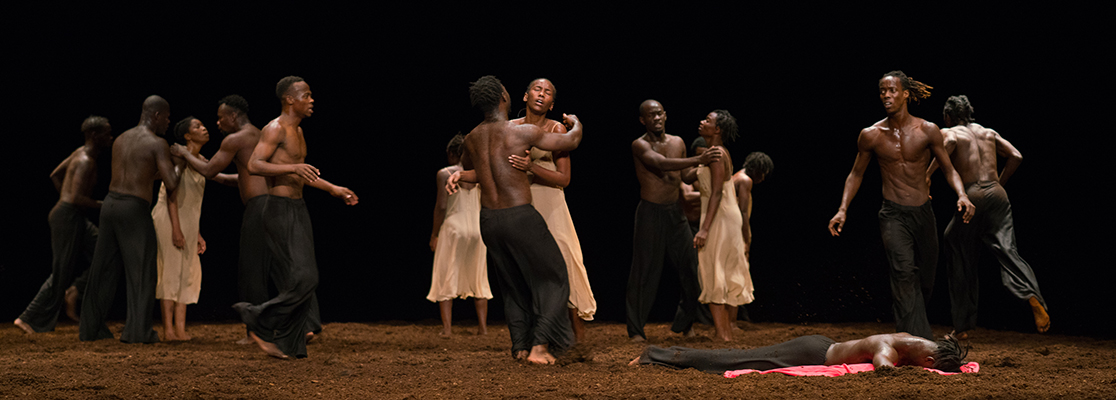
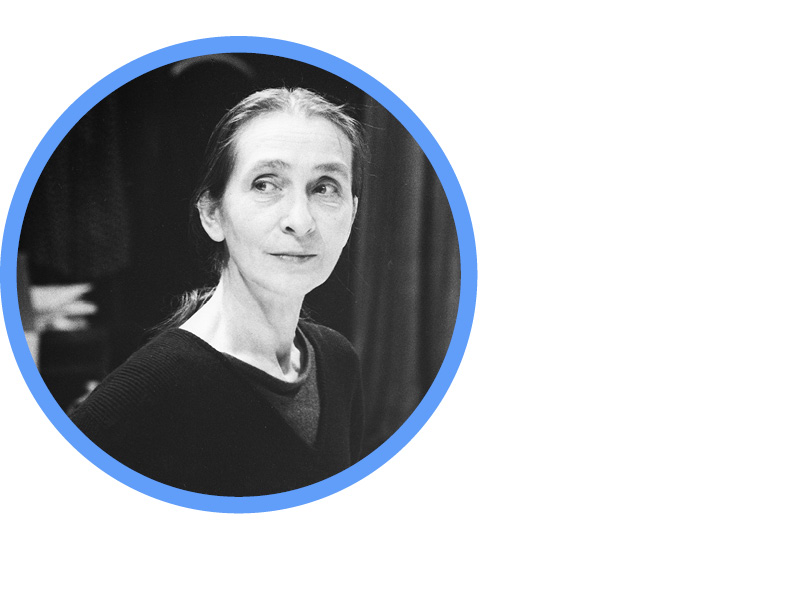
Pina Bausch
Choreographer - The Rite of Spring
Pina Bausch was born 1940 in Solingen and died 2009 in Wuppertal. She received her dance training at the Folkwang School in Essen under Kurt Jooss, where she achieved technical excellence. Soon after the director of Wuppertal's theatres, Arno Wüstenhöfer, engaged her as choreographer, from autumn 1973, she renamed the ensemble the Tanztheater Wuppertal. Under this name, although controversial at the beginning, the company gradually achieved international recognition. Its combination of poetic and everyday elements influenced the international development of dance decisively. Awarded some of the greatest prizes and honours world-wide, Pina Bausch is one of the most significant choreographers of our time.
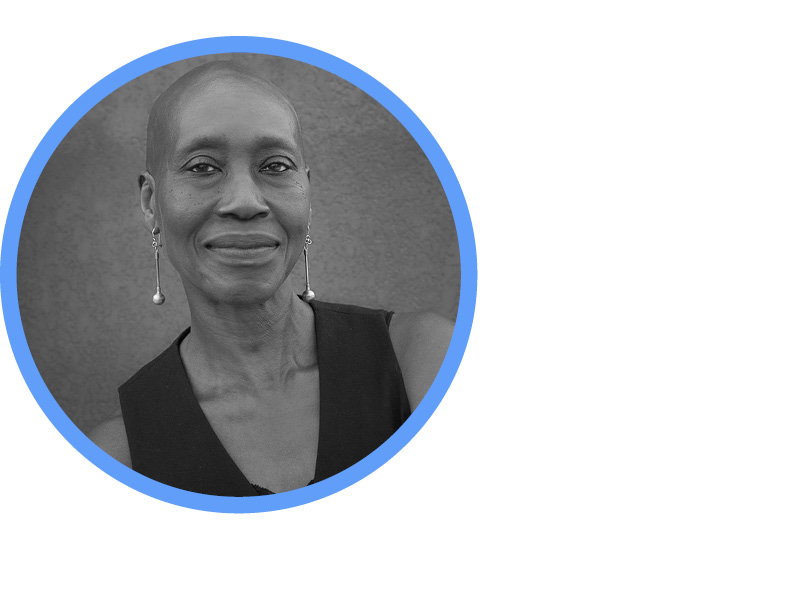
Germaine Acogny
Choreographer & Dancer - common ground[s]
Senegalese French dancer, teacher and choreographer Germaine Acogny is known as the ‘mother of contemporary African dance’. She studied at the École Simon Siegel in Paris and established her first dance studio in Dakar in 1968. There, she developed her own technique for Modern African dance, combining the influence of dances she had inherited from her grandmother, a Yoruba priestess, with her knowledge of traditional African and occidental dance.
Between 1977 and 1982, Acogny was the artistic director of Mudra Afrique (Dakar), before moving to Toulouse in 1985, where she and her husband, Helmut Vogt, founded the Studio-École-Ballet-Théâtre du 3è Monde. In 1995, she returned to Senegal and established an international education centre for traditional and contemporary African dances, l’École des Sables.
In 1998, she started her own dance company, Jant-Bi, whose productions include Les écailles de la mémoire – Scales of memory (2008), a collaboration with Urban Bush Women, and notably, Fagaala, based on the genocide in Rwanda and winner of a Bessie Award (2007). Acogny’s other prominent works and credits include Sahel (1987), YE’OU (1988 – winner of the London Contemporary Dance and Performance Award 1991), Tchouraï (2001), Bintou Were - a Sahel Opera (2007), Songook Yaakaar (2010), Mon élue noire – Sacre no.2, choreography Olivier Dubois, (2014, based on the original music of The Rite of Spring, winner of a Bessie Award 2018) and A un endroit du début (2015). In 2021, she won the Golden Lion of the Biennale de la Danse in Venice.
Acogny is a respected emissary of African dance and culture and continues to collaborate with schools, dance centres and teach masterclasses worldwide.

Malou Airaudo
Choreographer & Dancer - common ground[s]
Born in Marseille in 1948, Malou Airaudo began dancing at the age of eight, at the Opéra de Marseille. At seventeen, she joined the Ballet Russe de Monte-Carlo, where she became a soloist working with Léonide Massine, before joining Françoise Adret and her Ballet-Théâtre-Contemporain in 1968.
Early 1970s, she moved to New York to work with Paul Sanasardo and Manuel Alum, the latter choreographing the solo Woman of a Mystic Body for Airaudo. It is there that she meets Pina Bausch for the first time.
In 1973, she was invited by Pina Bausch to join her in Wuppertal, Germany where the director of the city’s theatres Arno Wüstenhöfer had just appointed her at the head of the Wuppertal Ballet, which she soon renamed the Tanztheater Wuppertal. Airaudo became one of the key figures of the ensemble, creating major roles in various productions, such as Iphigenie auf Tauris, Orpheus und Eurydike, Café Müller and dancing The Rite of Spring as well as in many other pieces.
She was also a founding member of Parisian dance company La Main, along with Jacques Patarozzi, Dominique Mercy, Helena Pikon and Dana Sapiro, and worked with choreographer Carolyn Carlson at the Teatrodanza La Fenice in Venice.
From 1984 until 2018, she taught dance at the Folkwang University of the Arts in Essen-Werden, and in 2012, she became the Director of the university’s Institute of Contemporary Dance.
Her choreographic accomplishments include Le Jardin des Souvenirs, Jane, Je Voudrais Tant, Schwarze Katze and If You Knew, created from the mid-90s onward for companies such as the Folkwang Tanz Studio, the Ballet de Nancy, the Ballet de Geneva, the Ballet du Nord and the Venice Biennale. In the last decade, she has also worked with Pottporus Renegade Theatre creating work with break-dancers like Irgendwo and Verlorene Drachen.
Fabrice Bouillon LaForest
Composer - common ground[s]
Musician, writer and composer, Fabrice is the Artistic Director of French FAUN(es) Collectif, alongside dancer Sébastien Cormier. He’s a long-time collaborator of Germaine Acogny (Fagaala, Songook Yaakaar, A un Endroit du Début) and École des Sables. Familiar to the world of dance (original scores for Nora Chipaumire, Urban BushWomen, Pittsburgh’s Dance Alloy Theatre, Kota Yamazaki, Don’t Hit Mama, Patrick Acogny, Cie Virevolt), he’s the co-founder of circus company Hors Surface with performer Damien Droin. He has created and performed several shows including Tetraktys, Boat and Fabulomania.
His work spans videogames to pop and rock. Under the alias 'LaForest' he has released two albums, co-written the documentary film Rimanere (Alexandre Lopez), and created and led many art projects designed for rural/remote environments. With Sébastien Cormier and musician Tristan Assant, he is touring LaForest as a singer and frontman of a multidisciplinary music/dance project.
Zeynep Kepekli
Lighting Designer - common ground[s]
Istanbul-born Zeynep Kepekli is a London-based designer who predominantly works with light. She has a long-standing collaboration with the Richard Alston Dance Company and Yorke Dance Project. Some of her design credits include: Sea of Troubles (The Royal Ballet); Playground, Between and Within, Imprint (Yorke Dance Project); Dance Journeys (English National Ballet); Collapse (New Movement Collective); Lie of the Land, Unfinished Business, Darkness Visible, Madcap, Burning, Rejoice in the Lamb, Buzzing around the Hunisuccle, Carnival, Cut and Run, Detour, Brahms Hungarian, A Far Cry, Shine On (RADC).
Mainly working in dance, her work focuses on architecture and the movement of body and light.
Sophiatou Kossoko
Dramaturg - common ground[s]
Sophiatou studied modern dance and ballet at the Doug Crutchfield Dance School in Copenhagen. She completed her training by doing workshops with teachers, artists, and choreographers from various dance backgrounds. She obtained her bachelor’s degree in Performing Arts – Dance Path and continued her studies at the University of Paris 8ème in France.
Sophiatou founded the company IGI, its focus being to create, produce and present artistic projects that combine dance with other disciplines such as singing, music, theatre, and visual arts, to explore the relationships between the world’s cultural differences. IGI offers a range of educational activities on a regular basis in collaboration with institutions and artists. Sophiatou choreographed Tchouraï, a solo for Germaine Acogny.
The choreographer Olivier Dubois also invited her to create a piece, Allégorie, for Danswindow. One of her poems is being published in présences by le printemps des poètes.
Petra Leidner
Costume Designer - common ground[s]
Petra Leidner has been Costume Director at Wuppertaler Bühnen und Sinfonieorchester GmbH since 2011. She has also been the Costume Director for Burgfestspiele Jagsthausen for over 6 seasons.
Since 1992, Petra has been Costume Director at Tanztheater Wuppertal Pina Bausch and has worked on all premieres and revivals of the company’s productions, in close collaboration with Marion Cito. In recent years, she has supervised and been responsible for costume design and consultation for various productions by Pina Bausch, for the Pina Bausch Foundation. Petra opened her own costume studio in 2013.
Igor Stravinsky
Music - The Rite of Spring
Russian composer Igor Stravinsky (1882–1971) was acclaimed for his many stage works, including the original ballets Petrushka, Agon, The Firebird, Apollo, Scènes de ballet and The Rite of Spring, as well as the opera The Rake’s Progress. Stravinsky was born in Oranienbaum, Russia, in 1882 and raised in St. Petersburg. He first gained his acclaim in the early 1900s for his compositions for the Ballets Russes, including The Rite of Spring. In Switzerland and subsequently France, he continued his work, composing such works as Persephone and Renard. In 1939, Stravinsky moved to the United States and completed his Symphony in C. Stravinsky remained in the United States until his death in 1971 in New York City, at which point he had a repertoire of more than 100 works to his name. Stravinksy is revered as one of the most influential composers of the 20th century.
Rolf Borzik
Original Set & Costume Design - The Rite of Spring
Rolf Borzik was born in 1944 in Posen and initially studied drawing and painting in Haarlem, Amsterdam and Paris from 1963 to 1966, then in 1967 graphics and design at the Folkwang School in Essen. Here, in 1970, he met Pina Bausch and from 1973 created sets and costumes for her in Wuppertal, making a decisive contribution to the look of dance theatre. Borzik died in January 1980 at the age of thirty-five.
About the Companies
The Rite of Spring / common ground[s] is a Pina Bausch Foundation, École des Sables & Sadler’s Wells production.
The Pina Bausch Foundation
Germany | Website
The Pina Bausch Foundation was established in 2009, shortly after the death of Pina Bausch, by her son Salomon Bausch. The charitable foundation based in Wuppertal owns the rights to the works and choreographies of Pina Bausch, along with the set and costume designs of Rolf Borzik and the extensive Pina Bausch Archives. The Foundation’s role is to carry Pina Bausch’s oeuvre forward into the future, disseminate it, and enable its performance.
The Pina Bausch Archives, holding photos, videos, and production details and documentation, serves as a knowledge resource. This resource, combined with the unique knowledge of Pina Bausch’s dancers, is the basis for the continued performance of the pieces. For this process, it is essential to continually pass on the knowledge to new dancers and train people to pass this knowledge on. In recent years, dancers took on the role of stagers, transmitting choreographies directly to dancers within and outside the Tanztheater Wuppertal. The Foundation aims at having many dancers and audiences experience Pina Bausch’s pieces on a personal level. Thus, pieces have been rehearsed with companies such as the Bavarian State Ballet, the English National Ballet, the Opera Ballet Vlaanderen, and the Paris Opera. The transmission of The Rite of Spring in co-production with the École des Sables and the Sadler’s Wells is the first time an ensemble is expressly formed to learn the choreography of one specific piece.
The Pina Bausch Archives continue to grow with each performance. Since November 2021, first materials are freely accessible on the Foundation’s website: pinabausch.org.
École Des Sables
Senegal | Website
École des Sables is an international centre for traditional and contemporary African dances, a school for theoretical and practical teaching, a laboratory for research, and a space for meetings and exchanges, conferences and artistic residences.
The school is dedicated to professional training for dancers from all over Africa in traditional and contemporary African dances. Its objectives are to professionalise African dancers, allowing them to be able to live from their art, and to encourage communication and collaboration between dancers, choreographers and companies from Africa and with the rest of the world; in short, to develop and promote contemporary African dance. Since 1998, the school has regularly organised professional training workshops gathering dancers and choreographers from Africa, the African diaspora and all over the world.
École des Sables was created in 1998 by Germaine Acogny, considered as “the mother of contemporary African Dance”, and her husband Helmut Vogt. Germaine Acogny is the former director of Mudra Afrique (1977-1982), a pan-African school founded by Leopold Sedar Senghor and Maurice Bejart, which has the objective of giving a professional education to African dancers and citizens to make them become responsible and autonomous through the art.
Sadler’s Wells
London | Website
Sadler's Wells is a world-leading creative organisation based in London committed to the making of dance, with over three centuries of theatrical heritage. Since 2005, Sadler’s Wells has created award-winning dance productions, co-productions and touring projects in collaboration with its portfolio of Associate Artists, as well as international dance companies and partners.
These include Russell Maliphant’s multi award-winning production PUSH with Sylvie Guillem; Crystal Pite’s Polaris with Thomas Adès; Gravity Fatigue, directed by fashion designer Hussein Chalayan; Sutra by Sidi Larbi Cherkaoui and sculptor Antony Gormley; Michael Keegan-Dolan’s Swan Lake/ Loch na hEala; productions by Carlos Acosta’s company Acosta Danza; Natalia Osipova’s Pure Dance; Botis Seva’s Olivier Award winning BLKDOG and William Forsythe’s A Quiet Evening of Dance.
Sadler’s Wells plays a significant role in the development of dance, bringing innovative and inspiring works to worldwide audiences. In the last 15 years, it has created 56 productions that have been enjoyed by 2.2 million people, with over 2,500 performances given at 388 venues in 48 countries. Sadler’s Wells productions have toured to some of the most prestigious theatres and festivals around the world, such as the Sydney Opera House, the Lincoln Center’s White Light Festival in New York, the National Centre for Performing Arts in Beijing, Chekhov International Theatre Festival in Moscow and Santiago a mil Festival in Chile.
2020 saw the world premiere of two new major productions: Message In A Bottle, a Sadler's Wells and Universal Music UK production by Kate Prince, based on the songs of Sting and Enter Achilles by Lloyd Newson, co-produced with Rambert; and The Rite of Spring/common ground[s] in partnership with the Pina Bausch Foundation and École des Sables, Senegal.
If you could pick up a dance piece, turn it inside out and look at the label, the words 'Made at Sadler's Wells' would be a guarantee of quality. Since 2005, the north London theatre has been a hotbed of dance creativity, commissioning and supporting some of the world's finest choreographers to make work.
The Scotsman






A Sustainable Festival
Adelaide Festival is proudly Carbon Neutral and you can help us reduce our impact on the environment further! Download the Reforest app to track your carbon footprint and plant trees in local reforestation projects to counteract your emissions.

